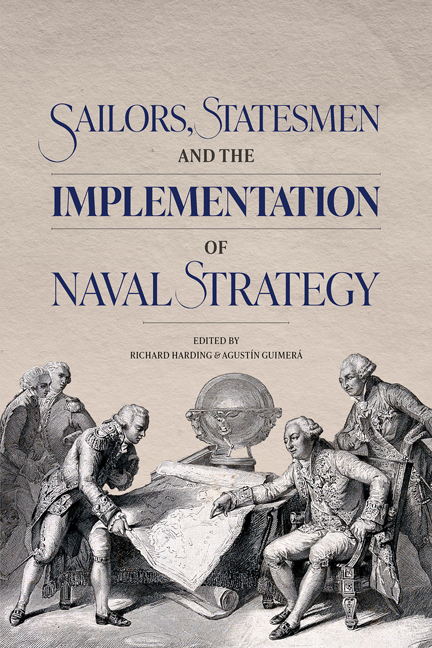Book contents
- Frontmatter
- Dedication
- Contents
- List of Contributors
- Introduction: Naval Leadership: Expertise and Strategy
- 1 The Evolution of French Naval Leadership: Defining the Admiralty of France from the Sixteenth to the Eighteenth Century
- 2 The Makers of Spanish Naval Strategy in the Eighteenth Century: Strategy, Tactics, and Shipbuilding Policy
- 3 Naval Strategic Leadership in Britain, 1739–1748: Political Leaders and Professional Knowledge
- 4 The Statesman and the Naval Leader: The Count of Floridablanca and Navy Minister Antonio Valdés, 1783–1792
- 5 Defining French Eighteenth-Century Naval Strategy
- 6 Casto Méndez Núñez: The Admiral who could have been Regent, 1861–1868
- 7 Teaching by Example: Julian Corbett’s The Campaign of Trafalgar of 1910
- 8 Spanish Naval Leadership during the Second Republic: José Giral Pereira
- 9 The Quest to Understand Naval Leadership: Educating Admirals for High Command in the U.S. Navy from the Eighteenth Century into the Twenty-first Century
- 10 Reflections
- Bibliography
- Index
2 - The Makers of Spanish Naval Strategy in the Eighteenth Century: Strategy, Tactics, and Shipbuilding Policy
Published online by Cambridge University Press: 08 May 2024
- Frontmatter
- Dedication
- Contents
- List of Contributors
- Introduction: Naval Leadership: Expertise and Strategy
- 1 The Evolution of French Naval Leadership: Defining the Admiralty of France from the Sixteenth to the Eighteenth Century
- 2 The Makers of Spanish Naval Strategy in the Eighteenth Century: Strategy, Tactics, and Shipbuilding Policy
- 3 Naval Strategic Leadership in Britain, 1739–1748: Political Leaders and Professional Knowledge
- 4 The Statesman and the Naval Leader: The Count of Floridablanca and Navy Minister Antonio Valdés, 1783–1792
- 5 Defining French Eighteenth-Century Naval Strategy
- 6 Casto Méndez Núñez: The Admiral who could have been Regent, 1861–1868
- 7 Teaching by Example: Julian Corbett’s The Campaign of Trafalgar of 1910
- 8 Spanish Naval Leadership during the Second Republic: José Giral Pereira
- 9 The Quest to Understand Naval Leadership: Educating Admirals for High Command in the U.S. Navy from the Eighteenth Century into the Twenty-first Century
- 10 Reflections
- Bibliography
- Index
Summary
During the eighteenth century, the Spanish Bourbon naval system evolved in two well-defined political and administrative phases, roughly divided by the outcome of the Seven Years War. This evolution, however, has seldom been understood from the perspective of strategy. The purpose of this article is to outline the evolution of Spanish naval strategy from the writings of four authors who have rarely been studied from this perspective, or who are practically unknown as strategic thinkers. The four plans described in this essay illustrate the evolution of Spanish naval thinking during both periods, showing not only the main objectives of Spanish foreign policy, but also the tasks that naval forces were expected to fulfil, their interaction with land forces, their relation to merchants and privateers, and the relation between naval strategy and shipbuilding policy.
In order to understand the origins of Spanish Bourbon naval strategic thought, is it necessary to consider the situation of Spanish naval forces during the late Spanish Habsburg period. During the second half of the seventeenth century, the main naval threat to the empire came from the rising power of Louis XIV's France. After having simultaneously fought the Dutch Revolt (1566–1648) and the Thirty Years War (1618–1648), the Spanish monarchy still had to combat the French armies until the Peace of the Pyrenees was signed in 1659. This, however, proved to be only a brief respite, and Franco-Spanish hostilities resumed during 1667–1668 (War of the Devolution), 1672–1678 (Franco-Dutch War), 1683–1684 (War of the Reunions), and 1689–1697 (War of the League of Augsburg). In this same period, the French monarchy followed a programme of mercantilist expansion, aimed at seizing a share of international commerce, which, in turn, led to confrontation with the English and the Dutch. These emerging maritime powers, on the other hand, fought three naval conflicts (1651–1654, 1665–1667, and 1672–1674) that led to important transformations in the European practice of war at sea. The traditional armed merchantman, improvised as a warship and used as an infantry rather than an artillery platform, became obsolete in the face of the specialised man-of-war, larger, strongly built, and primarily armed with heavy broadside cannon.
- Type
- Chapter
- Information
- Publisher: Boydell & BrewerPrint publication year: 2024



